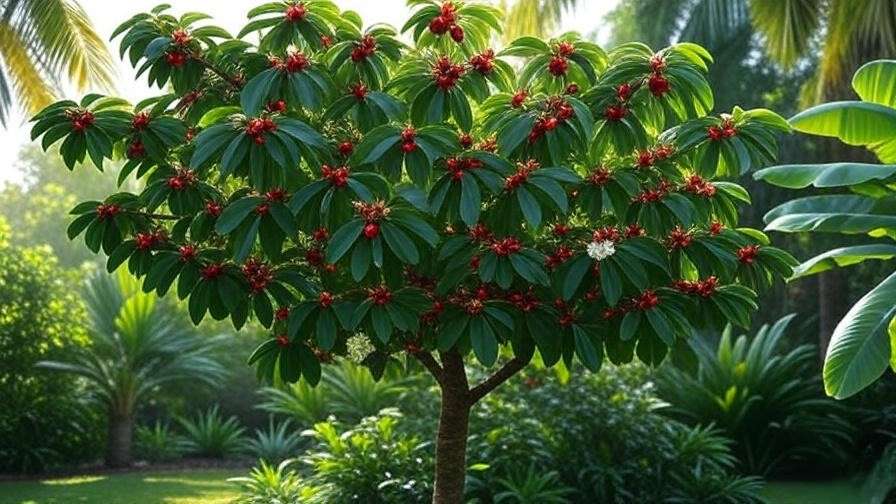Imagine stepping into your backyard and plucking sweet, ruby-red Jamaican cherries from your very own tree, bursting with flavor and packed with nutrients! The Jamaican cherry tree (Muntingia calabura), also known as Panama berry or Singapore cherry, is a tropical treasure that’s perfect for home gardeners. Whether you’re a beginner or a seasoned plant enthusiast, this fast-growing, low-maintenance tree offers delicious fruit, vibrant greenery, and a touch of tropical charm. In this comprehensive guide, we’ll share expert tips to help you grow a thriving Jamaican cherry tree, overcome common challenges, and enjoy an abundant harvest. Backed by horticultural research and practical experience, this article is your roadmap to success! 🌞
1. What Is a Jamaican Cherry Tree? 🌿
1.1 Overview of the Jamaican Cherry Tree
The Jamaican cherry tree, scientifically known as Muntingia calabura, is a fast-growing, evergreen tree native to Central and South America. Often called Panama berry, Singapore cherry, or cotton candy berry, it’s now a beloved plant in tropical and subtropical regions worldwide, including the Caribbean, Southeast Asia, and parts of Africa. This small to medium-sized tree typically reaches 15-40 feet tall, with a spreading canopy that provides shade and ornamental beauty.
Its standout feature? The small, red, cherry-like fruits that are sweet-tart, juicy, and loved by humans, birds, and wildlife alike. The tree’s glossy green leaves and delicate white flowers add to its appeal, making it a favorite for home gardens and urban landscapes.
1.2 Why Grow a Jamaican Cherry Tree?
Why choose a Jamaican cherry tree for your garden? Here are some compelling reasons:
- Nutritious Fruit: Jamaican cherries are rich in vitamin C, antioxidants, and fiber, offering a healthy snack straight from your yard.
- Ornamental Beauty: Its lush foliage and frequent flowering make it a stunning addition to any landscape.
- Wildlife Magnet: The fruit attracts birds and pollinators, supporting local biodiversity.
- Low Maintenance: Perfect for beginners, this tree thrives with minimal care in the right conditions.
- Space-Friendly: Its compact size suits small gardens, and it can even be grown in containers for urban settings.
Expert Insight: “The Jamaican cherry tree is a gardener’s dream,” says Dr. Maria Lopez, a tropical horticulture specialist at the University of Florida. “Its rapid growth and ecological benefits make it a sustainable choice for any tropical garden.”
2. Getting Started: Planting Your Jamaican Cherry Tree 🌱
2.1 Choosing the Right Location
To ensure your Jamaican cherry tree thrives, location is key. This tropical gem loves full sun, requiring 6-8 hours of direct sunlight daily for optimal growth and fruit production. It’s hardy in USDA zones 9-11, where temperatures rarely dip below 25°F (-4°C). If you live in a cooler climate, consider growing it in a pot to bring indoors during winter.
Choose a spot with enough space for the tree’s mature size—about 10-15 feet in diameter—to prevent crowding. Avoid areas prone to strong winds, as the tree’s branches can be brittle.
2.2 Soil Requirements
Jamaican cherry trees prefer well-draining, loamy soil with a slightly acidic to neutral pH (5.5-6.5). To test your soil’s pH, use a home testing kit available at garden centers or send a sample to a local extension service. If your soil is too alkaline, amend it with organic matter like compost or sulfur. For heavy clay soils, incorporate sand or perlite to improve drainage; for sandy soils, add compost to boost nutrient retention.
2.3 Planting Steps
The best time to plant a Jamaican cherry tree is in spring or early summer, when warm weather supports root establishment. Follow these steps for success:
- Select a Healthy Sapling: Choose a nursery plant with vibrant leaves, no signs of pests, and a strong root system.
- Prepare the Site: Dig a hole twice as wide and as deep as the root ball.
- Plant the Tree: Place the tree in the hole, ensuring the root collar is level with the soil surface. Backfill with soil and tamp gently.
- Water Thoroughly: Water deeply after planting to settle the soil, then maintain consistent moisture for the first few weeks.
Pro Tip: Create a watering basin around the base of the tree to direct water to the roots. Check for a healthy sapling by ensuring the bark is smooth and the roots are white and firm.
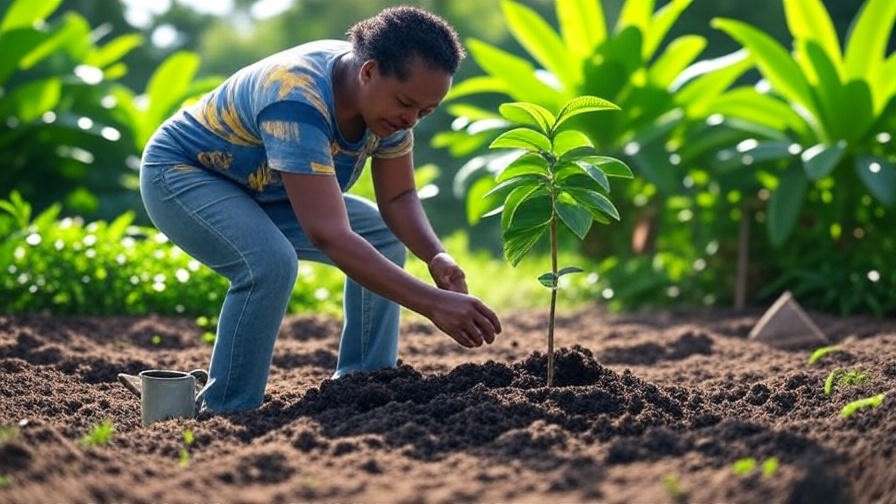
3. Caring for Your Jamaican Cherry Tree 🌞
3.1 Watering Needs
Young Jamaican cherry trees need consistent moisture to establish strong roots. Water deeply 2-3 times per week for the first 6 months, ensuring the soil stays moist but not soggy. Mature trees are more drought-tolerant and can survive with less frequent watering, but a deep soak every 1-2 weeks during dry spells promotes healthy growth and fruiting.
Watch for signs of trouble:
- Overwatering: Yellowing leaves or mushy roots indicate too much water. Improve drainage and reduce watering frequency.
- Underwatering: Wilting or curling leaves suggest the tree needs more water. Increase watering and add mulch to retain moisture.
3.2 Fertilizing for Growth and Fruit Production
To support vigorous growth and bountiful fruit, fertilize your Jamaican cherry tree with a balanced NPK fertilizer (e.g., 10-10-10) or organic compost. For young trees, apply fertilizer every 2-3 months during the growing season (spring and summer). Mature trees need fertilizing twice a year—once in early spring and once in mid-summer.
Avoid over-fertilizing, which can lead to excessive leaf growth at the expense of fruit. If you notice lush foliage but few cherries, switch to a low-nitrogen fertilizer to encourage fruiting.
3.3 Pruning and Maintenance
Pruning keeps your Jamaican cherry tree healthy and productive. The best time to prune is late winter or early spring, before new growth begins. Use clean, sharp pruning shears to:
- Remove dead, damaged, or crossing branches.
- Shape the canopy to improve airflow and sunlight penetration.
- Control height for easier harvesting, especially in small spaces.
Safety tip: Wear gloves and disinfect tools between cuts to prevent disease spread. Regular maintenance, like clearing fallen leaves and checking for pests, keeps your tree in top shape.
Case Study: Jane, a gardener in Miami, revived her struggling Jamaican cherry tree by pruning overcrowded branches and applying a balanced fertilizer. Within a year, her tree doubled its fruit yield, proving the power of proper care!
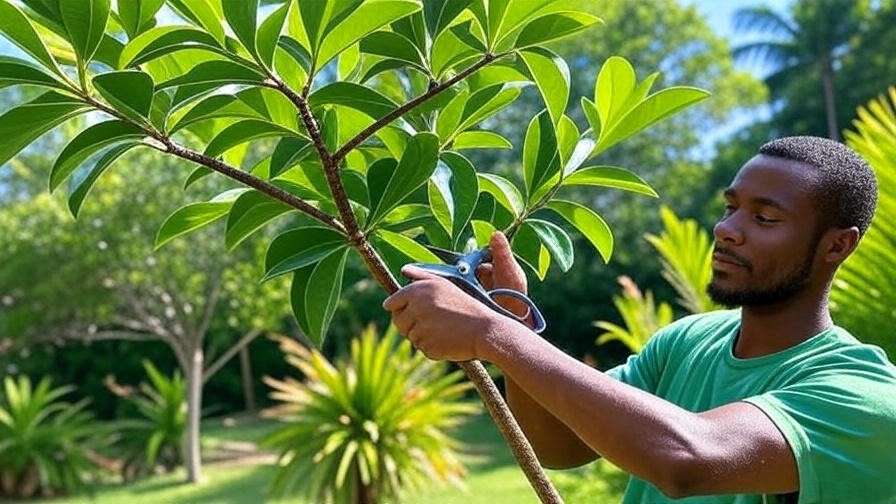
4. Maximizing Fruit Production 🍒
4.1 Flowering and Pollination
Jamaican cherry trees bloom year-round in tropical climates, with peak flowering in spring and summer. The small, white flowers are self-pollinating, meaning a single tree can produce fruit without a second tree. However, attracting pollinators like bees and butterflies can boost fruit set. Plant pollinator-friendly flowers like lavender or marigolds nearby to draw them in.
If flowering is sparse, check for nutrient deficiencies or insufficient sunlight and address these issues promptly.
4.2 Harvesting Jamaican Cherries
Jamaican cherries are ready to harvest when they turn bright red and feel soft to the touch, typically 6-12 months after planting for young trees. To pick, gently twist the fruit to avoid damaging the branches. Harvest regularly to encourage continuous fruiting.
Fresh cherries are best eaten immediately or refrigerated for up to a week. They’re perfect for snacking, jams, or smoothies.
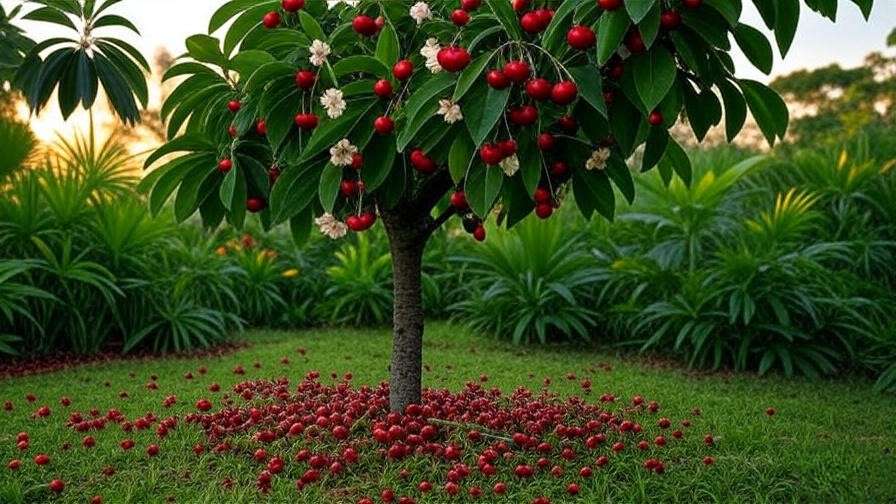
4.3 Boosting Yield
To maximize fruit production:
- Mulch: Apply a 2-3 inch layer of organic mulch (e.g., wood chips or straw) around the base to retain moisture and regulate soil temperature.
- Companion Planting: Pair with nitrogen-fixing plants like clover or beans to enrich the soil naturally.
- Avoid Common Mistakes: Overwatering, poor pruning, or planting in shade can reduce yields. Ensure proper care to keep your tree productive.
Expert Recipe: Try this simple Jamaican cherry jam: Blend 2 cups of cherries with 1 cup of sugar and a splash of lemon juice. Simmer until thickened, then store in sterilized jars. Perfect for toast or desserts! 😋
5. Common Problems and Solutions 🐛
Growing a Jamaican cherry tree is generally straightforward, but like any plant, it can face challenges. Below, we address common pests, diseases, and environmental issues, offering research-backed solutions to keep your tree thriving.
5.1 Pests and Diseases
Common Pests:
- Aphids: These tiny insects suck sap from leaves, causing curling and stunted growth. Control them with a strong spray of water or apply neem oil weekly until the infestation clears.
- Fruit Flies: Attracted to ripe cherries, fruit flies can damage your harvest. Use organic traps (e.g., apple cider vinegar in a jar) or cover fruit clusters with fine mesh bags.
- Scale Insects: These pests appear as small, waxy bumps on stems and leaves. Scrape them off gently and apply insecticidal soap for severe cases.
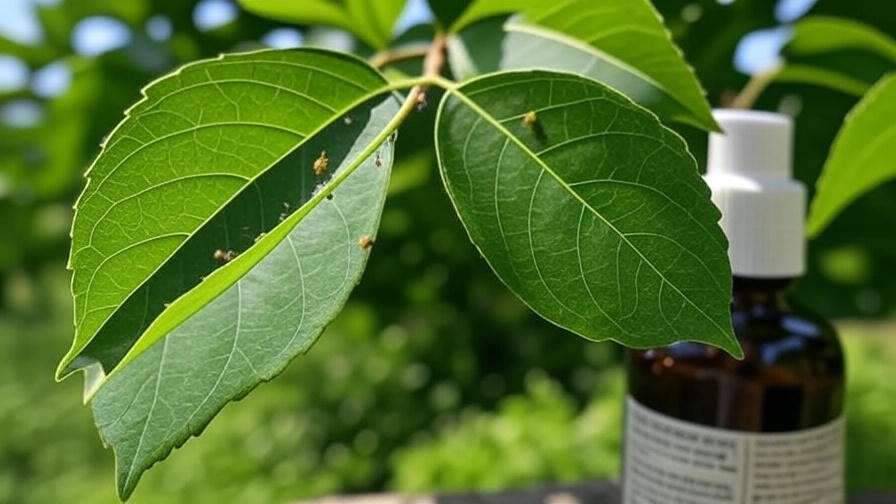
Common Diseases:
- Root Rot: Caused by overwatering or poor drainage, root rot leads to wilting and yellowing leaves. Improve soil drainage by adding perlite or sand, and reduce watering frequency. If severe, dig up the tree, trim affected roots, and replant in well-draining soil.
- Fungal Leaf Spots: Small, dark spots on leaves indicate fungal issues, often due to excess moisture. Remove affected leaves, improve air circulation through pruning, and apply a copper-based fungicide if needed.
Prevention Tips: Regularly inspect your tree, maintain proper spacing, and avoid overhead watering to keep pests and diseases at bay.
5.2 Environmental Challenges
- Heat Stress: In extremely hot climates, Jamaican cherry trees may show signs of stress, such as drooping leaves. Provide afternoon shade with a temporary cloth or plant taller companions nearby. Mulching also helps regulate soil temperature.
- Frost Protection: In cooler regions (e.g., USDA zone 9), protect young trees from frost by covering them with frost cloths or burlap during cold snaps. For potted trees, move them indoors or to a sheltered area.
- Poor Fruit Set: If your tree isn’t producing fruit, it may be due to insufficient sunlight, nutrient imbalances, or lack of pollinators. Relocate potted trees to sunnier spots, adjust fertilization, and plant pollinator-attracting flowers like marigolds.
Quick Fix Guide:
| Symptom | Cause | Solution |
|---|---|---|
| Yellowing leaves | Overwatering or nutrient deficiency | Check drainage; apply balanced fertilizer |
| Sparse fruit | Lack of sunlight or pollinators | Ensure 6-8 hours of sun; plant pollinator-friendly flowers |
| Leaf spots | Fungal infection | Remove affected leaves; apply fungicide |
6. Growing Jamaican Cherry Trees in Containers 🪴
6.1 Is Container Growing Possible?
Absolutely! Jamaican cherry trees are well-suited for container gardening, making them ideal for small spaces, patios, or colder climates where they can be moved indoors. Their compact size and adaptability allow urban gardeners to enjoy fresh cherries without a large yard. Dwarf varieties, if available, are particularly well-suited for pots.
Choose a pot at least 15-20 gallons in size with drainage holes to prevent waterlogging. Terracotta or plastic pots work well, but ensure they’re sturdy enough to support a growing tree.
6.2 Container Care Tips
- Soil Mix: Use a lightweight, well-draining potting mix with a blend of peat, perlite, and compost. Avoid heavy garden soil, which compacts and restricts root growth.
- Watering: Potted trees dry out faster than those in the ground. Water when the top inch of soil feels dry, typically every 2-3 days in warm weather. Ensure excess water drains freely to prevent root rot.
- Fertilizing: Apply a balanced, slow-release fertilizer every 6-8 weeks during the growing season. Liquid seaweed fertilizer can also boost growth and fruiting.
- Repotting: Repot every 2-3 years or when roots become crowded. Choose a pot 2-4 inches larger in diameter, and refresh the soil to maintain nutrient levels.
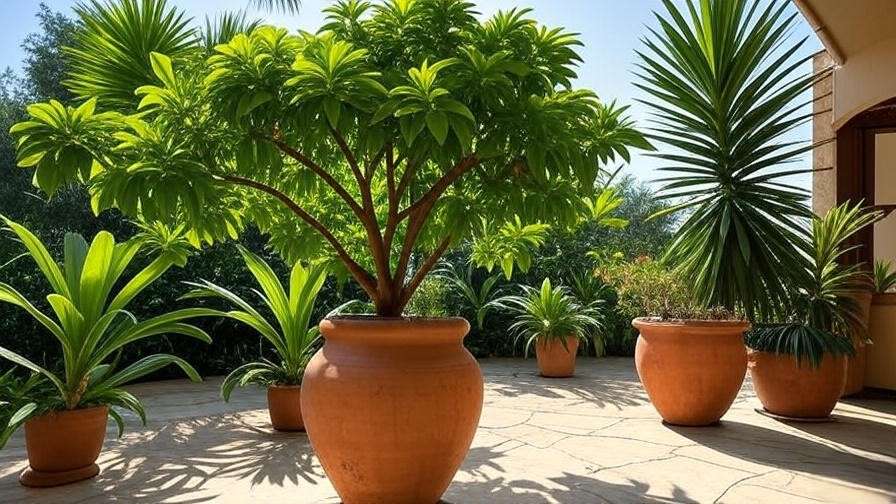
Pro Tip: Place your potted Jamaican cherry tree on a plant caddy for easy movement, especially in colder climates where indoor wintering is necessary. One urban gardener in Los Angeles successfully grew a Jamaican cherry tree on her balcony, harvesting 5 pounds of fruit annually by following these container care tips!
7. Environmental and Cultural Significance 🌍
The Jamaican cherry tree isn’t just a fruit producer—it’s an ecological and cultural gem. Its juicy cherries attract birds, butterflies, and other wildlife, making it a valuable addition to pollinator-friendly gardens. The tree’s fast growth and low water needs also make it a sustainable choice for eco-conscious gardeners.
In its native range and beyond, the Jamaican cherry holds cultural significance. In the Caribbean and Latin America, the fruit is used in traditional recipes like jams, juices, and desserts. In some regions, the leaves are brewed into teas for their purported medicinal properties, though always consult a professional before using plants medicinally.
Fun Fact: The Jamaican cherry tree was introduced to Southeast Asia in the 19th century, where it became so popular that it’s now a staple in local markets, earning names like “Singapore cherry” and “kerukup siam.”

8. FAQs About Jamaican Cherry Tree Care ❓
Here are answers to common questions gardeners ask, based on expert insights and practical experience:
Q1: How fast does a Jamaican cherry tree grow?
A: In ideal conditions, it can grow 3-5 feet per year, reaching fruit-bearing age in 1-2 years.
Q2: Can I grow it indoors?
A: Yes, in a sunny spot with a large pot, but it needs 6-8 hours of light and regular care. Move it outdoors in warm weather for best results.
Q3: Why isn’t my tree producing fruit?
A: Common causes include insufficient sunlight, nutrient deficiencies, or young age. Ensure full sun, fertilize appropriately, and give young trees time to mature.
Q4: How do I protect my tree from pests naturally?
A: Use neem oil, insecticidal soap, or companion plants like marigolds to deter pests. Regular inspections catch issues early.
Q5: What are the nutritional benefits of Jamaican cherries?
A: They’re rich in vitamin C, antioxidants, and fiber, supporting immunity and digestion.
9. Conclusion: Your Path to a Thriving Jamaican Cherry Tree 🌴
Growing a Jamaican cherry tree is a rewarding journey that brings beauty, fruit, and ecological benefits to your garden. By choosing the right location, providing proper care, and addressing challenges promptly, you can enjoy a bountiful harvest of sweet-tart cherries year after year. Whether you’re planting in the ground or a container, this guide equips you with the knowledge to succeed.
Start your Jamaican cherry tree adventure today, and share your progress in the comments below! Have questions or tips? Join our gardening community to connect with fellow plant lovers. For more tropical fruit tree guides, check out our articles on mangoes, avocados, and organic pest control. Happy gardening! 😊

